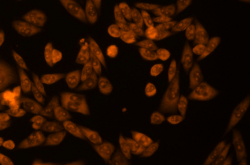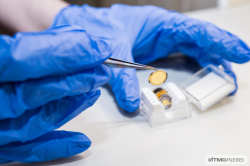A biofilm is a colony of microorganisms that has been placed within an extracellular polymer matrix produced by the microorganisms themselves. By changing the properties of the surface on which biofilm is grown, scientists can manipulate the growth process of the polymer matrix. Studying this process allows us to understand the mechanisms that form the three-dimensional structure of polymer matrices created by microorganisms.
In the future, such research will help develop ways to prevent their formation and facilitate their removal. In addition, biofilms produced by nonpathogenic microorganisms can be used in the development of dynamic biological materials.

A series of experiments on growing E. coli in a special transparent incubator installed on the object table of a stereoscopic microscope was conducted with the goal of performing macroscopic spatiotemporal characterization of the geometry of microorganism colonies. Images of the biofilm samples were taken once every 30 minutes for five days.
The research was carried out by the Infochemistry Scientific Center within the framework of a project on the development of smart materials for bacterial film programming and in collaboration with the Max Planck Institute of Colloids and Interfaces (Germany).





